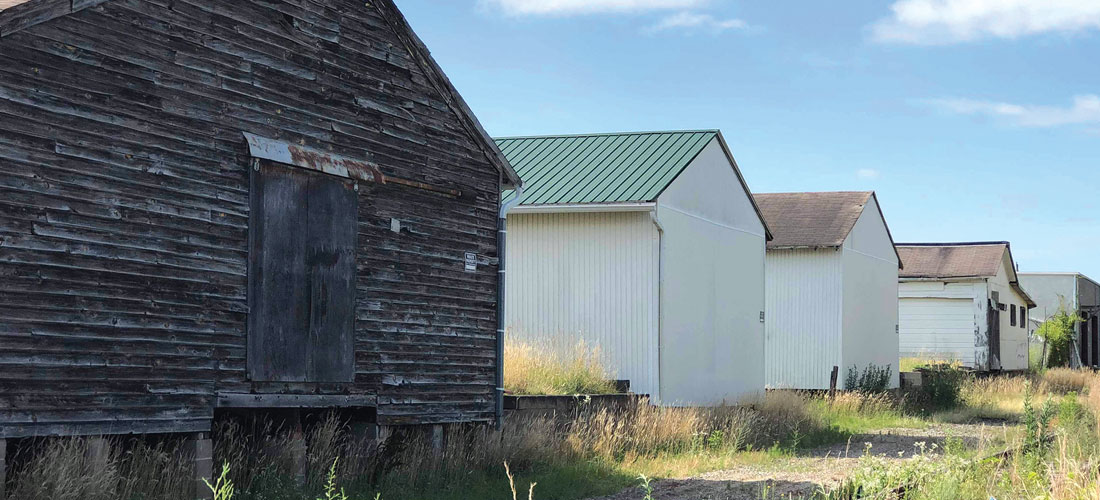
Greensboro’s War Effort
Remnants of the ORD recall the Gate City’s role in World War II
By Billy Eye
“They’re Germans, don’t mention the war.” — Basil Fawlty
Greensboro’s Army
Air Forces base was commissioned 75 years ago, all the excuse I needed to wander the confines of what was once Basic Training Camp No. 10 / Overseas Replacement Depot, an essential WWII installation. It was huge. Beginning at Summit, the facility, also known as ORD, extended outward in both directions from Bessemer Avenue down to English Street. It was bounded to the south by Lee Street (now Gate City Boulevard) while extending northward well past Wendover.
In operation from 1943 until 1946, the camp was initially charged with training and outfitting airmen and WACs; after V-J Day the mission shifted to processing returning troops back into civilian life.
It was an enormous operation requiring 3,200 permanent military personnel and hundreds of civilians. Trainees of note included motion picture stars Donald O’Connor and Sabu (Dastagir), the Elephant Boy, but by far the most famous recruit was future movie idol Charlton Heston who was married, yes, right here in Greensboro days before shipping out in 1944.
After the base was decommissioned, the land, some 650 acres, was parceled out for Summit Shopping Center, Alpat Restaurant, Best Products, McKnight Hardware, subdivisions and other varied interests. In the 1950s a golf course occupied the area where the sprawling rifle range had once been. NCA&T’s athletic field fits neatly inside that footprint today.
Despite decades of rampant development, remnants of BTC-10 / ORD are there for those willing to poke around a bit.
Venture east down Bessemer from Summit, and look for Bojangles’ on your left. The red brick building directly behind the drive-thru on Westside Drive was one of the nine Post Exchanges (PXs). Expanded in the rear for an auto parts store post-war, the facade is exactly as it once was, with a rusty signpost (sans sign) still standing at attention out front.
Two doors down is an honest to goodness metal Quonset hut that served as Chapel No. 1, unless this building was moved from its original spot. There are two other Quonsets that I know of inside the center city limits, one off South Elm and another on Lydon Street.
Continuing down Bessemer, that triangular patch of grass across from KFC was where the headquarters building once stood, hence the name of the street. Shame it couldn’t have been preserved. I had a peek inside before its demolition a few years ago, a good portion of it appearing as eerily vacant as it must have looked when the last recruits locked the doors behind them in 1946.
Taking a right off Bessemer onto Winston you’ll see an unrestored, vacant metal building made “off limits” by fencing. Note the cinderblock foundation. These structures were never meant to be anything but temporary. We were going to win the war after all!
Beginning at Warehouse Street and continuing over to English you’ll find, perhaps, the highest concentration of the remains of ORD. Those neat rows of warehouses, wooden frames now covered in vinyl siding, were originally processing centers for troops arriving by train. The easily recognizable train depot, end of the ORD line, is currently a Berico fuel distribution center, seen in the top right corner of the above photo taken by Col. Paul Younts.
A block north on English Street are two side-by-side troop barracks, one with original doors and plank-wood front porch.
To the east on Cain Street sits another barrack, repurposed as a lodge hall. I believe this is the location where some 300 German POWs were housed, just outside the camp’s perimeter. Because of a manpower shortage, many Germans spent their days working on nearby farms and were apparently well-liked. African-American soldiers complained, rightfully, that enemy combatants were afforded better accommodations than they were.
Long gone is the massive Kitty Hawk Amphitheater and the multiple dance halls and nightclubs featuring entertainers such as Louis Armstrong, Benny Goodman, Ronald Reagan with wife Jane Wyman, Jeanette MacDonald, opera singer Grace Moore, boxer Max Shapiro, and Lon Chaney. ORD’s Officer’s Club was reputed to be the nation’s finest.
Greensboro’s Army Air Forces base was a proving ground for thousands of fighter pilots, bombardiers and crucial personnel engaged in a war that, by necessity, would have to be won in the skies.
Heroes all. We stand in their shadows.
***
On a related note, VFW Post 386 at 1206 American Legion Drive will be holding their highly anticipated hot dog sale from 9 a.m. to 2:30 p.m. beginning the first Saturday after Labor Day and continuing on Saturdays through April. OH
Billy Eye would love to write a book on ORD if someone would fund it. Thanks to photographer Nathan Stringer for the modern ORD pics you just enjoyed.





